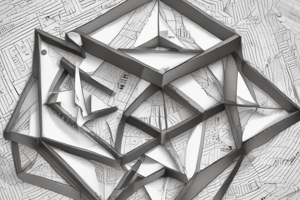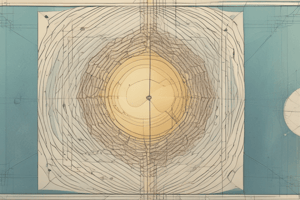Podcast
Questions and Answers
What is the surface area of a cube with a side length of 5cm?
What is the surface area of a cube with a side length of 5cm?
- 125cm^2
- 100cm^2
- 150cm^2 (correct)
- 120cm^2
What is the intersection of sets A = {1, 2, 3, 4} and B = {3, 4, 5, 6}?
What is the intersection of sets A = {1, 2, 3, 4} and B = {3, 4, 5, 6}?
- {1, 2, 5, 6}
- {1, 6}
- {3, 4} (correct)
- {1, 2, 3, 4, 5, 6}
What is the formula for the sum of n terms in an arithmetic sequence?
What is the formula for the sum of n terms in an arithmetic sequence?
- S_n = (n/2)(a_1 + a_n) (correct)
- S_n = (n/2)(a_1 - a_n)
- S_n = n(a_1 + a_n)
- S_n = n(a_1 - a_n)
What type of pattern is the sequence: 2, 4, 8, 16, ...?
What type of pattern is the sequence: 2, 4, 8, 16, ...?
What is the surface area of a cylinder with a radius of 3cm and a height of 6cm?
What is the surface area of a cylinder with a radius of 3cm and a height of 6cm?
What is the complement of set A = {1, 2, 3, 4} in a universal set U = {1, 2, 3, 4, 5, 6}?
What is the complement of set A = {1, 2, 3, 4} in a universal set U = {1, 2, 3, 4, 5, 6}?
Flashcards are hidden until you start studying
Study Notes
Surface Area Of 3D Shapes
- Formulae:
- Surface area of a cube: 6s^2, where s is the side length
- Surface area of a rectangular prism: 2(lw + lh + wh), where l, w, and h are the length, width, and height
- Surface area of a sphere: 4πr^2, where r is the radius
- Surface area of a cylinder: 2πr(h + r), where r is the radius and h is the height
- Key concepts:
- Surface area is the total area of all the faces of a 3D shape
- It is measured in square units (e.g. m^2, cm^2, etc.)
Set Operations
- Union: The combination of all elements in two or more sets
- Notation: A ∪ B (read as "A union B")
- Intersection: The set of elements common to two or more sets
- Notation: A ∩ B (read as "A intersection B")
- Difference: The set of elements in one set but not in another
- Notation: A - B (read as "A minus B")
- Complement: The set of all elements not in a given set
- Notation: A' (read as "A prime")
Arithmetic Sequence Formulas
- General formula: a_n = a_1 + (n-1)d, where a_n is the nth term, a_1 is the first term, n is the term number, and d is the common difference
- Formula for the nth term: a_n = a_1 + (n-1)d
- Formula for the sum of n terms: S_n = (n/2)(a_1 + a_n)
Pattern Recognition
- Types of patterns:
- Number patterns (e.g. arithmetic, geometric, quadratic)
- Shape patterns (e.g. geometric, fractal)
- Visual patterns (e.g. pictures, graphs)
- Key concepts:
- Pattern recognition involves identifying and extending a sequence of numbers or shapes
- It requires understanding of relationships between elements and the ability to generalize
Problem Solving Strategies
- Key strategies:
- Read the problem carefully and understand the question
- Identify the key elements and variables
- Choose a suitable method or approach
- Break down complex problems into simpler sub-problems
- Check and verify the solution
- General tips:
- Draw diagrams or graphs to visualize the problem
- Use algebraic or numerical methods to solve equations
- Work backwards from the solution to check its validity
- Consider alternative solutions or approaches
Surface Area Of 3D Shapes
- Surface area is the total area of all the faces of a 3D shape, measured in square units (e.g. m^2, cm^2, etc.)
- The formula for the surface area of a cube is 6s^2, where s is the side length.
- The surface area of a rectangular prism is 2(lw + lh + wh), where l, w, and h are the length, width, and height.
- The surface area of a sphere is 4πr^2, where r is the radius.
- The surface area of a cylinder is 2πr(h + r), where r is the radius and h is the height.
Set Operations
- The union of two sets is the combination of all elements in both sets, denoted as A ∪ B.
- The intersection of two sets is the set of elements common to both sets, denoted as A ∩ B.
- The difference of two sets is the set of elements in one set but not in another, denoted as A - B.
- The complement of a set is the set of all elements not in the given set, denoted as A'.
Arithmetic Sequence Formulas
- The general formula for an arithmetic sequence is a_n = a_1 + (n-1)d, where a_n is the nth term, a_1 is the first term, n is the term number, and d is the common difference.
- The formula for the nth term is a_n = a_1 + (n-1)d.
- The formula for the sum of n terms is S_n = (n/2)(a_1 + a_n).
Pattern Recognition
- Pattern recognition involves identifying and extending a sequence of numbers or shapes.
- Number patterns can be arithmetic, geometric, or quadratic.
- Shape patterns can be geometric or fractal.
- Visual patterns can be pictures or graphs.
Problem Solving Strategies
- Read the problem carefully and understand the question to ensure accurate solutions.
- Identify key elements and variables to break down complex problems.
- Choose a suitable method or approach to solve the problem.
- Break down complex problems into simpler sub-problems to solve them step-by-step.
- Check and verify the solution to ensure its validity.
- Draw diagrams or graphs to visualize the problem and make it more manageable.
- Use algebraic or numerical methods to solve equations.
- Work backwards from the solution to check its validity.
- Consider alternative solutions or approaches to ensure the most efficient solution.
Studying That Suits You
Use AI to generate personalized quizzes and flashcards to suit your learning preferences.




